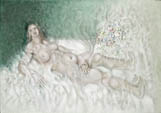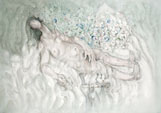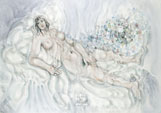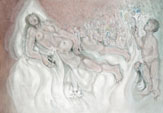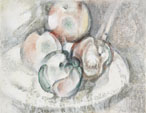The figure in le Brocquy's Odalisques conjures a sequence
of moods, conveyed through colour variations and amendments of pose and
staffage woman, cat, boy, flowers. Odalisque 1 is alert, lying naked
on her bed against a modulated rich green background. Her fingers are in
sensitive tactile motion, suggested by filmy, equivocal paintwork, and
the flower bunch by her left leg makes a painterly burst of red, blue,
white and yellow. She has a wide-awake erotic charge, the ripples playing
across the picture surface suggesting that she may be lying not on a bed,
but in the shallow end of a warm, inviting swimming-pool. Odalisque 2,
the most overtly sexual of the group, is fast asleep and, with her elongated
neck and thrown back head, evidently dreams with flowers that are now not
a bunch, but a river flowing luxuriously around her. In Odalisque 3 we
see an explosion of summer flowers. The woman is sitting upright, awake
and aware, with intense green eyes looking slightly to the left of the
viewer; the cat sleeps. The last of the quartet, Odalisque 4, is asleep,
and visited by a small naked boy who gives her flowers. The cat beside
her is quietly watchful. There is a voluptuous pink tonality here, the
body and bedclothes interpenetrating, and the whole articulated by gauzy
red and pink flowing crayon marks. Fluid lines circle round and round to
create, gently and lovingly, the form of legs, arms and breasts. Although he began with Manet's Olympia as the source,
le Brocquy moves outwards in the Odalisques through his own experience
as a painter, drawing on a reservoir of insight accumulated over a lifetime.
The ripples which unify the Odalisque canvases, and mingle image and background,
are continuations of the meandering lines which the young le Brocquy made
in pencil and pastel drawings of lovers in 1943 and 1944. There is a clear
thread joining le Brocquy's early work to these late statements, whose
line can be traced more or less clearly as it dips and rises, sharpens
and softens, across the intervening sixty or seventy years. The power in the Odalisques, when shown or reproduced
as a group, comes from the rehearsal and restatement of their theme, just
as a theme in music may be repeated with variations across the breadth
of the orchestra. Although we expect to have another decade at least of
le Brocquy's work to celebrate, this exhibition could be read as a triumphal
reworking at the symphony's close of a phrase introduced in the first movement.
When painting another of his persistent themes, the head image of W. B.
Yeats, le Brocquy came to understand the potency of the continued sequence: 'it was then I realised that a portrait can no longer
be the stable, pillared entity of Renaissance vision that the portrait
in our time can have no visual finality.' Restatement, whether in art or music, is renewal.
The titles of the eight paintings shown here have as their
common prefix 'Looking at' Looking at Manet, Velazquez, Goya, Cézanne.
They began as 'Homage to' these Masters, but le Brocquy's vision and translation
of his models is so searching, that he invites us not so much to pay homage,
but, as he has done all his life, to look at them again and again. Thus,
through le Brocquy's brush, we meet once again Velazquez' Don Sebastian
de Mora and Goya's Doña Antonia Zárate, we revisit the Villa
Medici in the footsteps of Velazquez, and we encounter, once again, four
ordinary apples and a knife that were first presented to us by Cézanne. James Hamilton, 2006.
Mick Wilson. Le Brocquy: To look, and then to look again, once more
Louis le Brocquy. Artist's Note |
